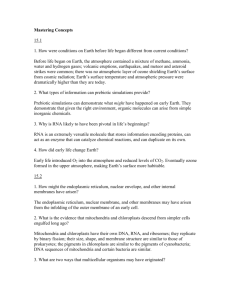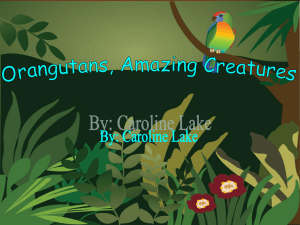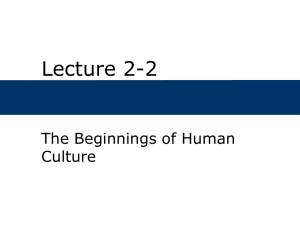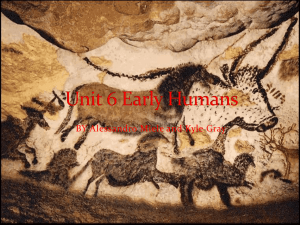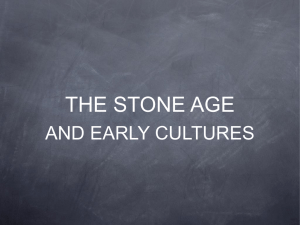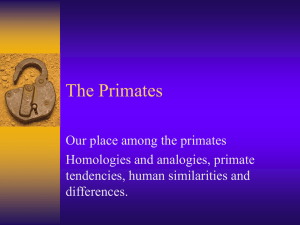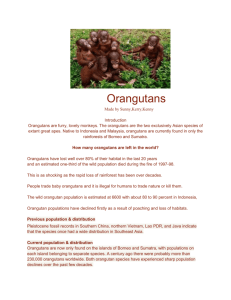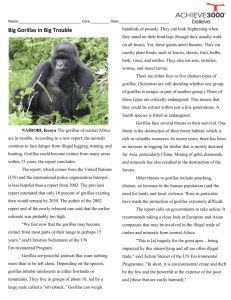Answers to Mastering Concepts Questions
advertisement
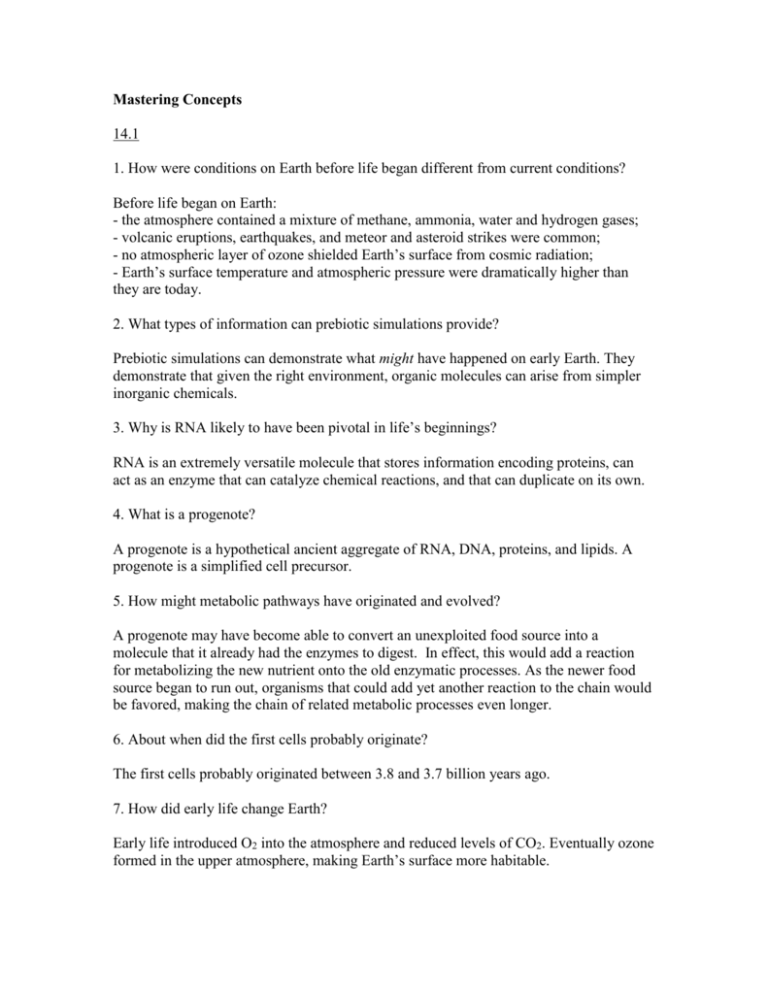
Mastering Concepts 14.1 1. How were conditions on Earth before life began different from current conditions? Before life began on Earth: - the atmosphere contained a mixture of methane, ammonia, water and hydrogen gases; - volcanic eruptions, earthquakes, and meteor and asteroid strikes were common; - no atmospheric layer of ozone shielded Earth’s surface from cosmic radiation; - Earth’s surface temperature and atmospheric pressure were dramatically higher than they are today. 2. What types of information can prebiotic simulations provide? Prebiotic simulations can demonstrate what might have happened on early Earth. They demonstrate that given the right environment, organic molecules can arise from simpler inorganic chemicals. 3. Why is RNA likely to have been pivotal in life’s beginnings? RNA is an extremely versatile molecule that stores information encoding proteins, can act as an enzyme that can catalyze chemical reactions, and that can duplicate on its own. 4. What is a progenote? A progenote is a hypothetical ancient aggregate of RNA, DNA, proteins, and lipids. A progenote is a simplified cell precursor. 5. How might metabolic pathways have originated and evolved? A progenote may have become able to convert an unexploited food source into a molecule that it already had the enzymes to digest. In effect, this would add a reaction for metabolizing the new nutrient onto the old enzymatic processes. As the newer food source began to run out, organisms that could add yet another reaction to the chain would be favored, making the chain of related metabolic processes even longer. 6. About when did the first cells probably originate? The first cells probably originated between 3.8 and 3.7 billion years ago. 7. How did early life change Earth? Early life introduced O2 into the atmosphere and reduced levels of CO2. Eventually ozone formed in the upper atmosphere, making Earth’s surface more habitable. 14.2 1. When did eukaryotic cells first appear? Eukaryotic cells arose between 1.4 and 1.9 billion years ago. 2. How might the endoplasmic reticulum, nuclear envelope, and other internal membranes have arisen in eukaryotic cells? The endoplasmic reticulum, nuclear membrane, and other membranes may have arisen from the infolding of the cell membrane of an early cell. 3. What is the evidence that mitochondria and chloroplasts descend from simpler cells engulfed long ago? Mitochondria and chloroplasts have their own DNA, RNA, and ribosomes; they replicate by binary fission; their size, shape, and membrane structure are similar to those of prokaryotes; the pigments in chloroplasts are similar to the pigments of cyanobacteria; DNA sequences of mitochondria and certain bacteria are similar. 4. When did the first multicellular organisms appear in the fossil record? The first multicellular organisms appeared in the fossil record about 1.2 billion years ago. 5. What are two ways that multicellular organisms may have originated? Multicellular organisms may have originated by individual cells merging to form a single organism, or by cells remaining stuck together after division. 14.3 1. When did the Ediacarans live, and what were they like? Ediacarans lived during the Precambrian, about 600 to 543 MYA. They were invertebrates, but no one is sure exactly what they were like. 2. What types of organisms flourished in the Cambrian? In the Cambrian, life was plentiful in the seas, including ediacarans, red and green algae, sponges, jellyfish, worms, trilobites, nautiloids, eurypterids, brachiopods, mollusks, and the animals of the Burgess Shale (which do not correspond to living invertebrates). 3. How did Paleozoic life diversify during the Ordovician, Silurian, Devonian, Carboniferous, and Permian periods? The Ordovician period was characterized by huge sea communities of algae and invertebrates. The first jawless fishes appeared in the Ordovician; life also moved onto land as primitive plants appeared. The Silurian saw the rise of vascular plants, terrestrial animals, and fungi. Fishes with jaws appeared, as well as freshwater fishes. The Devonian was dominated by fishes. Lobe-finned fishes appeared, as did amphibians. Plants diversified into ferns, horsetails, and seed plants. Amphibians flourished in the Carboniferous, as did coal forests and many large land insects. Bony fishes and sharks lived in the Carboniferous oceans. The Permian saw the prominence of gymnosperms and reptiles. 4. How did the Paleozoic era end? The Paleozoic period ended with mass extinctions of many forms of life. The Permian extinctions affected coastline life and may have been caused by a drop in sea levels, which dried out coastline communities. The concurrent rise in the level of atmospheric carbon dioxide raised global temperatures. 5. Which organisms came and went during the Mesozoic era? During the Mesozoic era, dinosaurs appeared and went extinct. So did thecodonts and therapsids, pterosaurs, and other non-dinosaurian lineages of reptiles. 6. How did the Mesozoic era end? The Mesozoic era ended with a mass extinction that destroyed nearly 75% of species living at that time. 7. Which new organisms arose during the Cenozoic era? During the Cenozoic, mammals (especially placental mammals) experienced a huge adaptive radiation. 14.4 1. Name and describe the three groups of contemporary primates. To which group do humans belong? The three groups of contemporary primates are prosimians (lemurs and others), simians (monkeys), and hominoids (apes). Humans are hominoids. 2. What can skeletal anatomy and DNA sequences in existing primates tell us about the study of human evolution? An understanding of skeletal anatomy of existing primates can help us understand human evolutionary history and the trends in human evolution. Primate anatomy allows us to infer the diets, body positions, sizes, and many other aspects of fossil humans and their ancestors. 3. What are the three groups of hominines in the human family tree, and which still exist today? The three existing groups of hominines in the human family tree are gorillas, chimps, and humans. Each group also contains members known only from fossils. 4. Which conditions may have contributed to the evolution of humans? Conditions that led to the evolution of humans are rooted in plate tectonics. After India and the Himalayan region collided with Eurasia, the rise of the Himalayas altered Africa’s climate. It became cooler and some tropical forests became grasslands. Ancestors of humans began to live on grasslands instead of in trees. 14.5 1. What information can researchers gain by comparing the human and chimpanzee genome sequences? Answers to many questions could come from comparing the genome sequences. Such questions include which genes make us human, what accounts for our uniquely human traits, and why do humans and chimpanzees have different diseases. 2. Comparing the chimpanzee and human genomes does not reveal which species has the “ancestral” form of each gene (the version present in the last common ancestor of humans and chimpanzees). How could genome sequences from orangutans or gorillas help scientists resolve which gene variants are ancestral? Orangutans and gorillas are a more “ancient” group; they shared a common ancestor with humans and chimps at an earlier time. Variations of genes in humans or chimps that are more like those in orangutans or gorillas could then be said to be the “ancestral” form of the gene. Write It Out 1. Panspermia suggests that life on Earth developed from primitive “spores” that arrived from outer space. Suppose it did so on multiple planets, eventually giving rise to humans (on Earth) and Star Trek’s Vulcans (on planet Vulcan). In that case, would humans be more closely related to Vulcans or to Earth species such as crabgrass and bread mold? Given your answer, does it seem likely that Star Trek’s Mr. Spock could have had one Vulcan and one human parent? Being earthlings, we would still be more related to other Earth species such as crabgrass and bread mold because we have evolved from one common ancestor on the same planet. Even if the same types of spores landed on Earth and on Vulcan, the evolutionary pathways that led to humans and Vulcans would probably have been very different. It would therefore be very unlikely that humans and Vulcans could interbreed. 2. About how soon after Earth formed did life first appear, according to fossil evidence? How much longer did it take for multicellular organisms to colonize land? Life first appeared shortly after Earth formed, perhaps about 3.85 BYA. 3. Review the structures of nucleic acids and proteins in chapter 2. What chemical elements had to have been in primordial “soup” to generate these organic molecules? Carbon, hydrogen, oxygen, nitrogen, phosphorus, and sulfur must have been present to have generated all of the amino acids and nucleotides currently found in life. 4. How might the first metabolic pathway have arisen? The first metabolic pathway may have arisen as natural selection favored organisms with enzymes that could convert one organic substance into another, perhaps as a way to exploit new food sources. 5. The amoeba Pelomyxa palustris is a single-celled eukaryote with no mitochondria, but it contains symbiotic bacteria that can live in the presence of O2. How does this observation support the endosymbiont theory? This observation supports the endosymbiont theory because it illustrates how a singlecelled eukaryotic organism can develop a symbiotic relationship with a species of bacteria. 6. The antibiotic streptomycin kills bacterial cells but not eukaryotic cells; diphtheria toxin kills eukaryotic cells but not bacteria. Which of these two substances do you predict would kill mitochondria and chloroplasts? Explain your answer. Mitochondria and chloroplasts arose from bacterial ancestors prior to the evolution of eukaryotes. They would therefore be susceptible to streptomycin but not diphtheria toxin. 7. List the major events of the Precambrian, Paleozoic, Mesozoic, and Cenozoic. Precambrian: Life originated, reproduced and diversified; photosynthesis evolved; O2 accumulated in Earth’s atmosphere; eukaryotes arose. Paleozoic: Sea supported huge communities of algae and invertebrates; vertebrates such as jawless fishes appeared; life ventured onto land in the form of primitive plants and arthropods; the first vascular plants evolved; the first freshwater fishes appeared; the oceans contained corals, trilobites, and mollusks; fishes with skeletons of cartilage or bone appeared; lobe-finned fishes appeared; ferns, horsetails, and seed plants appeared; scorpions, millipedes, and other invertebrates lived on the land; amphibians emerged; bony fishes and sharks were beginning to resemble modern forms; reptiles introduced the amniote egg, in which an embryo could develop completely in dry land; a major extinction event occurred. Mesozoic Era: Thecodonts shared forests with cycads, ginkgos, and early conifers; ancestral mammals appeared; dinosaurs dominated for over 120 million years; first flowering plants appeared; Archaeopteryx and ancestral birds appeared; an extinction event occurred in the Cretaceous period, ending the age of dinosaurs. Cenozoic Era: Marsupials (pouched mammals) appeared; 15 of the 18 modern orders of placental mammals arose; modern mountains and coastlines formed; grasslands began to replace the forest in some areas; Homo sapiens appeared in Africa and eventually colonized most of the planet. 8. Distinguish between the terms primate, hominid, hominine, and Homo. Primate: group of mammals including prosimians (tarsiers, lemurs, and the like), simians (monkeys), and apes. Hominid: group of primates including the great apes (orangutans, gorillas, chimpanzees, and humans. Hominine: group of hominids including gorillas, chimps, and humans. Homo: genus of hominines that includes several ancestral and modern humans. 9. Search the Internet for information about Homo floresiensis. What types of evidence are paleontologists using to place H. floresiensis on the human family tree? Evidence includes full bipedalism, human-like teeth, and use of tools and fire. 10. What can scientists learn by comparing the fossilized skeletons of extinct primates with the bones of modern species? The fossilized skeletons can yield important information regarding locomotion, posture, diet, and brain size. 11. The foramen magnum in Australopithecus africanus is closer to the front of the skull than in gorillas. What does this observation indicate about A. africanus? This shows that the spinal cord was oriented under the head like it is in humans and other bipedal species. 12. Use the Internet to learn about National Geographic’s Genographic Project. What are the main objectives and components of the project, and how are researchers using the information they gather to learn more about human evolution? The Genographic Project is trying to map the migration patterns of humans from our last common ancestral population to today. It uses DNA samples from hundreds of thousands of volunteers around the world and analyzes it with sophisticated software programs. 13. In what ways has culture been an important factor in human evolution? Culture has facilitated the development of language, knowledge, art, and our way of life. The ability to transmit knowledge from generation to generation has enabled us to learn from the past and has contributed greatly to our success as a species. 14. At one time, several species of Homo existed at the same time. Propose at least two hypotheses that might explain why only Homo sapiens remains. Perhaps Homo sapiens had greater intelligence and therefore greater reproductive success than the other species. Perhaps Homo sapiens interbred with the other species, eliminating the distinctions among them. Perhaps Homo sapiens killed off the other species. 15. How do you predict a scientist would respond to a question about whether humans “evolved from monkeys”? Humans did not “evolve” from monkeys. Humans do share a common ancestor with monkeys (indeed, with all primates), but monkeys are not our closest relatives. Chimpanzees are our closest relatives, but an ape did not turn into a human. Instead, a population of ancestral apes diverged into chimpanzees, humans, and other extinct and existing lineages. 16. The video game “Spore” invites players to design creatures and guide them through “five stages of evolution.” Search the Internet for information about “Spore,” then describe how evolution in this game is similar to, and different from, the evolution of life on Earth. Similar to evolution there is the appearance at later stages in the game of organisms of increased complexity starting with basic cells. In the game’s editor box players can spend DNA points to mutate their organism and change its traits, similar to how in evolution mutations can lead to new adaptive traits. Unlike evolution there is a goal at the end of each stage and the end of the game as a whole. Also, through the game the choices and actions of the player determines what the player starts with in the next stage (e.g. performing evil deeds vs. good). Such a transmission of traits is more Lamarckian than it is evolutionary. Pull It Together 1. What events mark the transitions between eras in the geologic timescale? The events that mark the differences between eras begin with the origin of life, followed by the oxygenation of the atmosphere including origin of eukaryotic life and multicellular life, followed by several mass extinctions. The beginning of human life marks the latest era. 2. How has the emergence of new species changed Earth’s history? New species are constantly emerging on Earth. Every one of them has contributed to the formation of the biosphere, some in particular having very large impacts (e.g., first photosynthetic species, first respiring species, first terrestrial species). 3. Create an additional concept map that depicts the evolution of humans. Build a concept map using figure 14.25 as a guide. “Ancestral primate” gave rise to “Prosimians”, “Monkeys”, and “Apes”. “Prosimians” lack an opposable thumb. “Monkeys” and “Apes” have an opposable thumb. “Monkeys” lack long arms, but have long legs and a tail. “Apes” have long arms, but lack long legs and a tail. “Apes” include “Gibbons”, “Orangutans”, “Gorillas”, Bonobos”, Chimpanzees”, and “Humans”. “Gibbons” move by “”Brachiation”. “Orangutans” move by “Fist-walking”. “Gorillas”, “Bonobos”, and “Chimpanzees” move by “Knuckle-walking”. “Humans” are “Bipedal”. 4. What scientific evidence supports human evolution? All scientific evidence points to the notion that every species that exists and has existed undergoes evolution. There is fossil, genetic, developmental, and comparative evidence supporting human evolution.
